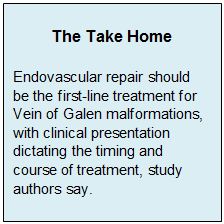Key Points:
- Review analyzes over 25 years of results for endovascular repair of Vein of Galen malformations
- Good clinical outcomes seen in more than two-thirds of patients
Endovascular embolization results in good outcomes for patients with Vein of Galen malformations, according to a systematic review published online July 31, 2015 ahead of print in the Journal of Neurosurgery.
Investigators, led by Shao-wen Xiao, MD, of The First Affiliated Hospital of Guangxi Medical University (Guangxi Province, China) collected data on 667 patients who underwent endovascular embolization (without adjuvant radiotherapy or combined surgery after the procedure) for the abnormality in 34 separate studies published between 1987 and 2012. Among these patients, 44% were neonates, 41% infants, and 12% children or adults.

Proportional meta-analysis demonstrated that 68% of patients achieved “good clinical outcome” Postembolization, an estimated 10% of patients died and 37% experienced complications, rates the researchers describe as “acceptable.” The most common complication was cerebral hemorrhage, which occurred in 5% of patients. Others were cerebral ischemia (6%), leg ischemia (3%), and vessel perforation (3%),
The mortality rate of embolized patients decreased over the study period, from 17% during the 1980s to 12% in the 1990s, and 2000s. Similarly, complication rates also decreased over that time, from 45% to 38% and 35%, respectively.
“The results suggest that advances in endovascular treatment have greatly improved the outcome of patients with [Vein of Galen malformations],” the study authors write. “With the development of science and technology, endovascular techniques have become more advanced, and thus are more beneficial to patients. Embolization treatment achieved so much progress that other methods such as microsurgery, Gamma Knife surgery, and medical management cannot be compared with endovascular treatment, especially in terms of the mortality rate.”
Timing, Staging Should Be Based on Clinical Presentation
However, the authors acknowledge limitations to the meta-analysis, including the small number of subjects, lack of randomization, and potential publication bias. Nevertheless, they conclude that it provides “a clear indication that endovascular treatment should be the first option for [vein of Galen malformations].”
Importantly, they stress that the timing and course of endovascular treatment is dictated by clinical presentation.
“This therapeutic window represents the optimal time for treatment,” Dr. Xiao and colleagues write. “Intracerebral hemorrhage and venous thrombosis can be avoided, to a large extent, by staging the embolization procedure. The goal is not complete occlusion of the lesion, but rather partial obliteration to redistribute blood flow to allow for normal cardiac and neurological development.”
Source:
Yan J, Wen J, Gopaul R, et al. Outcome and complications of endovascular embolization for vein of Galen malformations: a systematic review and meta-analysis. J Neurosurg. 2015;Epub ahead of print.
Disclosures:
- The study authors report no relevant conflicts of interest.

